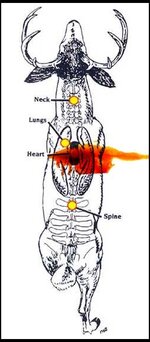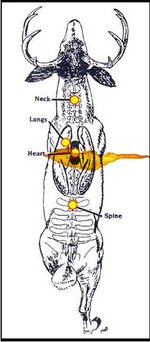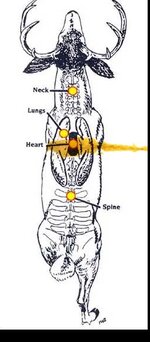Have been doing quite a bit of reading but have a question I have not been able to find answers on. I'll use the 77 grain TMK as an example - What I am seeing is a recommended impact velocity of 1900+. From your experience how much difference in damage is there between 2700 to 2300 and 1900. My overall question is if a bullet is designed for an impact range of 1900-2800, do you see many differences in damage throughout the recommended range with the more frangible bullets you recommend?
Bare with me, I’m doing this on my phone.
Yes sir you do with all bullets, however depending on which bullet type you get more consistent wound paths with some frangible bullets across the velocity range; or, acceptable terminal ballistics at higher velocity impact and greatly improved terminal effects at lower velocity.
In general with ELD-M and TMK’s at high impact velocity (above 2,400’ish FPS) you get massive wounds with most or all of the temporary stretch cavity becoming apart of the permanent cavity. No mono will cause this at any common velocity, and only soft bonded bullets at very high impact velocities (3,200’ish) will be comparable.
Between 2,400’ish and 2,100’ish FPS part of the temporary stretch cavity is still causing permanent damage due to fragments of bullets cutting tissue, but the total volume of the wound is less severe. No mono common mono will cause, and soft bonded bullets above 2,600’ish may. Below 2,100’ish FPS to around 1,800fps, most of the temporary stretch cavity is not permanent, however you do have fragments that cause permanent damage up to 4 inches or so from the main wound channel. This is the wound size that monos cause above 2,400’ish fps at best. Tougher onded bullets will be similar above 2,200-2,300fps.
For a pretty close visual reference using a a 6.5 CM and IIRC a 140gr ELD-M (though 130-147gr ELD-M and X, and TMK will be similar.
Above 2,400fps’ish impact

2,400-2,100’ish FPS impact (this is what a softer bonded will do at very high impact speeds-

2,100-1,800’ish FPS impact (this is what softer bonded at normal impact speed at best, and monos at very high impact speeds can look like) -

My experiences with bonded bullets have been that damage goes down slightly at the top ranges as velocity goes down and then significantly once the bottom ends are reached. For instance, my 165 grain Interbonds are intended to expand well down to 2000 FPS. In my particular setup, that is reached at 500 yards- my self imposed limit for quite a few reasons outside of bullet performance. I do see a difference in damage at say 200 yards vs 450 yards as the bullets has lost about 400 FPS.
No hidden agenda with the question- just trying to understand why I have experienced what I have as compared to what you have.
They’re good questions and your thoughts are correct. A kind of easier way to think about it is- the “tougher” a bullet is, the smaller the operating window for good performance will be. The same can be said for “frangible” bullets, which is why lightweight varmint bullets don’t penetrate very far. To over come that, you have to use heavy for caliber bullets when doing the ELD-M and X, Berger, TMK, etc. Then you get both sufficient penetration and exceptional wound channel sizes.



